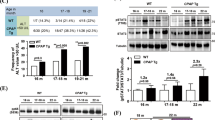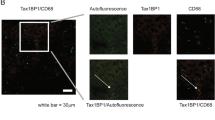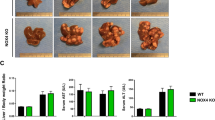Abstract
The causes of sporadic human cancer are seldom recognized, but it is estimated that carcinogen exposure and chronic inflammation are two important underlying conditions for tumour development, the latter accounting for approximately 20% of human cancer1. Whereas the causal relationship between carcinogen exposure and cancer has been intensely investigated2, the molecular and cellular mechanisms linking chronic inflammation to tumorigenesis remain largely unresolved1. We proposed that activation of the nuclear factor κB (NF-κB), a hallmark of inflammatory responses3 that is frequently detected in tumours4,5, may constitute a missing link between inflammation and cancer. To test this hypothesis, we studied the Mdr2-knockout mouse strain, which spontaneously develops cholestatic hepatitis followed by hepatocellular carcinoma6, a prototype of inflammation-associated cancer7. We monitored hepatitis and cancer progression in Mdr2-knockout mice, and here we show that the inflammatory process triggers hepatocyte NF-κB through upregulation of tumour-necrosis factor-α (TNFα) in adjacent endothelial and inflammatory cells. Switching off NF-κB in mice from birth to seven months of age, using a hepatocyte-specific inducible IκB-super-repressor transgene, had no effect on the course of hepatitis, nor did it affect early phases of hepatocyte transformation. By contrast, suppressing NF-κB inhibition through anti-TNFα treatment or induction of IκB-super-repressor in later stages of tumour development resulted in apoptosis of transformed hepatocytes and failure to progress to hepatocellular carcinoma. Our studies thus indicate that NF-κB is essential for promoting inflammation-associated cancer, and is therefore a potential _target for cancer prevention in chronic inflammatory diseases.
This is a preview of subscription content, access via your institution
Access options
Subscribe to this journal
Receive 51 print issues and online access
We are sorry, but there is no personal subscription option available for your country.
Buy this article
- Purchase on SpringerLink
- Instant access to full article PDF
Prices may be subject to local taxes which are calculated during checkout





Similar content being viewed by others
References
Coussens, L. M. & Werb, Z. Inflammation and cancer. Nature 420, 860–867 (2002)
Balmain, A. & Harris, C. C. Carcinogenesis in mouse and human cells: parallels and paradoxes. Carcinogenesis 21, 371–377 (2000)
Li, Q. & Verma, I. M. NF-κB regulation in the immune system. Nature Rev. Immunol. 2, 725–734 (2002)
Mayo, M. W. & Baldwin, A. S. The transcription factor NF-κB: control of oncogenesis and cancer therapy resistance. Biochim. Biophys. Acta 1470, M55–M62 (2000)
Lin, A. & Karin, M. NF-κB in cancer: a marked _target. Semin. Cancer Biol. 13, 107–114 (2003)
Mauad, T. H. et al. Mice with homozygous disruption of the mdr2 P-glycoprotein gene. A novel animal model for studies of nonsuppurative inflammatory cholangitis and hepatocarcinogenesis. Am. J. Pathol. 145, 1237–1245 (1994)
Nakamoto, Y., Guidotti, L. G., Kuhlen, C. V., Fowler, P. & Chisari, F. V. Immune pathogenesis of hepatocellular carcinoma. J. Exp. Med. 188, 341–350 (1998)
Block, T. M., Mehta, A. S., Fimmel, C. J. & Jordan, R. Molecular viral oncology of hepatocellular carcinoma. Oncogene 22, 5093–5107 (2003)
De Vree, J. M. et al. Correction of liver disease by hepatocyte transplantation in a mouse model of progressive familial intrahepatic cholestasis. Gastroenterology 119, 1720–1730 (2000)
Staudt, L. M. Molecular diagnosis of the hematologic cancers. N. Engl. J. Med. 348, 1777–1785 (2003)
Lavon, I. et al. High susceptibility to bacterial infection, but no liver dysfunction, in mice compromised for hepatocyte NF-κB activation. Nature Med. 6, 573–577 (2000)
Gupta, S. Hepatic polyploidy and liver growth control. Semin. Cancer Biol. 10, 161–171 (2000)
Bruix, J., Boix, L., Sala, M. & Llovet, J. M. Focus on hepatocellular carcinoma. Cancer Cell 5, 215–219 (2004)
Chaisson, M. L., Brooling, J. T., Ladiges, W., Tsai, S. & Fausto, N. Hepatocyte-specific inhibition of NF-κB leads to apoptosis after TNF treatment, but not after partial hepatectomy. J. Clin. Invest. 110, 193–202 (2002)
Maeda, S. et al. IKKβ is required for prevention of apoptosis mediated by cell-bound but not by circulating TNFα. Immunity 19, 725–737 (2003)
Beg, A. A., Sha, W. C., Bronson, R. T., Ghosh, S. & Baltimore, D. Embryonic lethality and liver degeneration in mice lacking the RelA component of NF-κB. Nature 376, 167–170 (1995)
Lavon, I. et al. Nuclear factor-κB protects the liver against genotoxic stress and functions independently of p53. Cancer Res. 63, 25–30 (2003)
Friedberg, E. C., McDaniel, L. D. & Schultz, R. A. The role of endogenous and exogenous DNA damage and mutagenesis. Curr. Opin. Genet. Dev. 14, 5–10 (2004)
Wang, J. S. & Groopman, J. D. DNA damage by mycotoxins. Mutat. Res. 424, 167–181 (1999)
Eferl, R. et al. Liver tumor development. c-Jun antagonizes the proapoptotic activity of p53. Cell 112, 181–192 (2003)
Ehrhardt, H. et al. TRAIL induced survival and proliferation in cancer cells resistant towards TRAIL-induced apoptosis mediated by NF-κB. Oncogene 22, 3842–3852 (2003)
Kennedy, N. J. & Davis, R. J. Role of JNK in tumor development. Cell Cycle 2, 199–201 (2003)
Tang, G. et al. Inhibition of JNK activation through NF-κB _target genes. Nature 414, 313–317 (2001)
Papa, S. et al. Gadd45 β mediates the NF-κ B suppression of JNK signalling by _targeting MKK7/JNKK2. Nature Cell Biol. 6, 146–153 (2004)
Greten, F. R. et al. Ikkβ links inflammation and tumorigenesis in a mouse model of colitis-associated cancer. Cell 118, 285–296 (2004)
Wilson, J. & Balkwill, F. The role of cytokines in the epithelial cancer microenvironment. Semin. Cancer Biol. 12, 113–120 (2002)
Radisky, D., Hagios, C. & Bissell, M. J. Tumors are unique organs defined by abnormal signaling and context. Semin. Cancer Biol. 11, 87–95 (2001)
Acknowledgements
Mdr2-knockout mice were a gift from R. P. Oude Elferink and the TALAP1 mice were received from H. Bujard. We are grateful to N. Berger, T. Golub and N. Kidess-Bassir for technical assistance, to A. Hatzubai, O. Mandlboim, N. Lieberman, G. Kojekaro, M. Davis and H. Harel for helping with MRI, FACS, mRNA and protein analysis. We thank K. Meir and M. Oren for discussions and a critical reading of the manuscript. This research was supported by grants from the Israel Science Foundation funded by the Israel Academy for Sciences and Humanities (Center of Excellence Program), Prostate Cancer Foundation Israel—Center of Excellence, German-Israeli Foundation for Scientific Research and Development (GIF, in collaboration with H. Bujard), a grant in memory of H. and F. Brody from H. M. Krueger as trustee of a charitable trust and the Israel Cancer Research Foundation (ICRF). I.S. is supported by the Lady Davis Fellowship Trust.
Author information
Authors and Affiliations
Corresponding authors
Ethics declarations
Competing interests
The authors declare that they have no competing financial interests.
Supplementary information
Rights and permissions
About this article
Cite this article
Pikarsky, E., Porat, R., Stein, I. et al. NF-κB functions as a tumour promoter in inflammation-associated cancer. Nature 431, 461–466 (2004). https://doi.org/10.1038/nature02924
Received:
Accepted:
Published:
Issue Date:
DOI: https://doi.org/10.1038/nature02924



